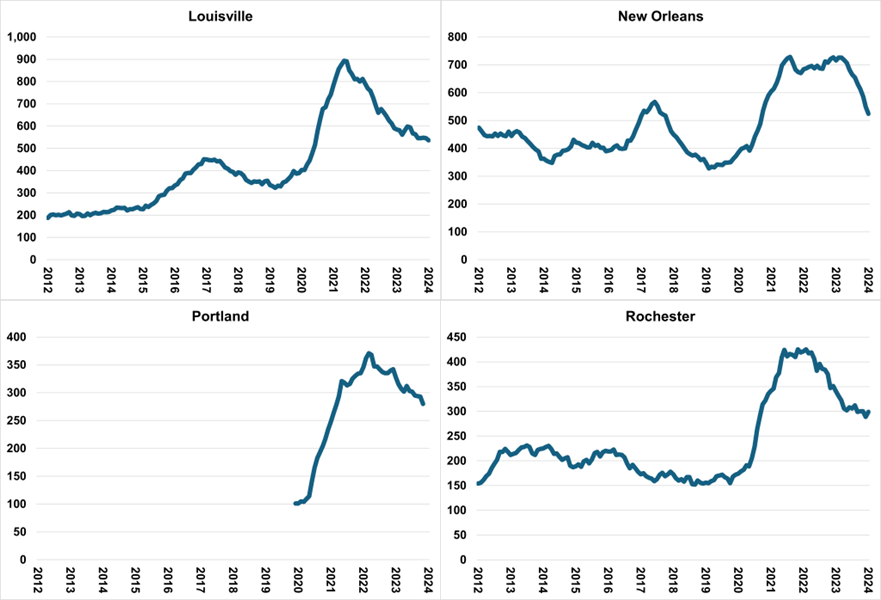Gun Violence Has (Mostly) Returned to Pre-2020 Levels In A Lot Of Places
Examining gun violence trends in 18 cities with available data.
Shooting data can be quite difficult to come by, especially at the incident or victim level. Every few months I’ve tried to measure out the gun violence trends in cities with available data as the best means of extrapolating bigger picture national gun violence trends. To that end, I grabbed shooting data from 18 cities that make it available and made graphs of shootings rolling over 12 months.
Quick caveat: New Orleans, Buffalo and Syracuse are fatal and non-fatal shooting incident counts while Washington DC is just fatal shootings. Every other city contains fatal and non-fatal shooting victims. I tried to go as far back as possible though not every city has tons of historical data. Each city at least had data through 2019.
I’ve lumped each of the 18 cities into groups based on the level of gun violence in that city relative to the early 2020 (or earlier where available) timeframe. I chose early 2020 as the reflection point because, you know, everything broke shortly thereafter.
At, Near, or Below Pre-2020 Levels
Most of the cities (12 of 18) experienced gun violence at roughly the same level as they did before 2020 threw a wrench in everything. Some cities — like Baltimore and Boston — are seeing gun violence fall well below where it was in early 2020 (though gun violence in Baltimore is still well above where it was before 2015).
Most of the above cities had sizable increases in 2020, and most are pretty close to where they were before that sizable increase (within at least 20%). New York likely had the fewest shooting victims in February 2024 of any month since February 2020. There were 1,607 shooting victims in Philadelphia between February 2023 and January 2024 compared to over 2,500 shooting victims at peak and 1,535 shooting victims in the 12 months leading up to the surge. There were 2,896 shooting victims between February 2023 and January 2024 in Chicago compared to 4,400 at peak and 2,720 in the period leading up to the surge. That’s still an astoundingly high number of shooting victims in these cities but also represents a marked decline over the last few years.
Falling But Still Higher
Four cities have seen sharp declines in gun violence over the last few years but the declines either started later or haven’t been as sharp as those in the above cities. Still, all four of these cities are down sharply from their peaks of gun violence.
Elevated And Not Falling
Two cities — Seattle and DC — stand out for having not experienced declining gun violence yet. Both cities appeared to be seeing a dip in late 2022 before that trend reversed. There are other places — such as Memphis — that would undoubtedly fit with this group if that city published gun violence data, but there aren’t a ton of such cities with available data showing a sustained rise in gun violence.
Another way of looking at this issue is to compare each city’s total over the last 12 months of available data to the 12 months preceding COVID (March 2019 to February 2020). Note that shooting data for Baltimore, Seattle, Buffalo, and Portland only goes through January 2024 while the other cities have data through February. Almost all of these cities saw a surge in gun violence in 2020, and shootings are down relative to pre-COVID in 4 of the cities, it’s down or within single digit percentage points in 10 of the cities, and is within about 20 percent in 12 of the cities.
(NOTE: An original version of this table used the wrong denominator for the percent change. A corrected version has replaced it. Apologies for the error!)
It’s worth noting that shootings in New Orleans over the last 6 months are virtually equal to where they were in the 6 months leading up to COVID (202 vs 203), and New York City shootings are falling rapidly though still slightly higher than pre-COVID.
Gun violence is clearly falling nationally which shows up in city samples and it shows up in Gun Violence Archive data. Of course, one could (rightly) argue that even the pre-COVID level of gun violence was too high, and appreciating that the trend is downward does not signal approval for the level of violence. The question now, though, is whether it will continue to fall back to pre-2020 levels, plateau above it, or start to increase.






I have a friend who retired from Memphis’ PD. They don’t want to publish that data, it would look terrible.
How did you pull the shooting data for New Orleans? I am struggling a lot. I am trying to pull the data from their open data portal (ex 2024: https://data.nola.gov/Public-Safety-and-Preparedness/Electronic-Police-Report-2024/c5iy-ew8n), but I am noticing several issues, like repeat 'item_number' that seem too big. For example: 'A-11290-21'.